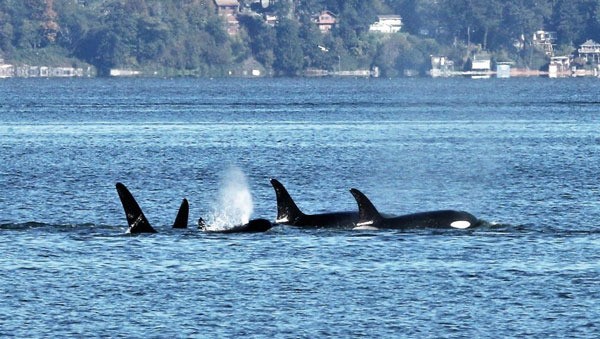PRESS RELEASE | ORCA NETWORK — Southern Resident orcas have arrived in Puget Sound.
Members of J and K pods (and L87 who travels with J pod) were seen early this month crossing into Admiralty Inlet, continuing south and making their way to Point No Point, Hansville on the Kitsap Peninsula by nightfall. Orca Network Whale Sighting Network volunteers followed the movements of the pods from shore-based perches on Whidbey Island to Vashon Island and many points in between, collecting sightings information used by researchers, agencies and organizations working to help endangered Southern Resident orcas.
“As the fall progresses and the winter season approaches, the SRKW [Southern Resident killer whales] have historically shifted their attention from Fraser River Chinook salmon to chum salmon headed for rivers in Puget Sound,” said Deborah Giles of the Center for Whale Research report, in a news release. “This shift in prey is celebrated by orca enthusiasts as the whales make more frequent trips to waters viewable from South Puget Sound shorelines. Given the decline of Chinook salmon throughout the whales’ historical range, Puget Sound bound salmonid species have become that much more important to the whales from October through early Spring.”
Since the 2005 Federal listing of the Southern Resident orcas under the Endangered Species Act, Orca Network has assisted National Oceanic Atmospheric Administration Fisheries and the Center for Whale Research to help track the orcas’ winter travels in Puget Sound and along the outer coast. According to Ken Balcomb, founder of the Center for Whale Research, this orca community often can’t find enough salmon to survive. Less than half of the females within their reproductive years have brought healthy calves into the population in recent years. The first step is to help salmon spawn and survive to adulthood.
“We have to consider the ecological solution here,” Balcomb said.
This time of year offers wonderful opportunities to observe orcas from the many miles of shoreline on Whidbey Island, the Kitsap and Olympic Peninsulas, and the inland waters of Puget Sound. For 16 years, Orca Network’s Whale Sighting Network has encouraged whale watching from shore, or about state ferries in inland waters.
Orca Network again this year trained another 45 new volunteer whale observer/naturalists from Island, Snohomish, King, Kitsap, Pierce, Thurston, and Whatcom counties.
“Our volunteers are provided with up to date ID guides and information to share with others while viewing whales from the shoreline, to educate about the orcas, their habitat, and prey,” said Whale Sighting Network Coordinator Alisa Lemire Brooks.
Staff and volunteers are also on the lookout for new calves or missing whales; on Nov. 10, 2015, Orca Network’s Alisa Lemire Brooks and Orca Network/Langley Whale Center volunteer Sara Hysong-Shimazu observed and photographed a new calf from Alki Point in Puget Sound, later confirmed by the Center for Whale Research to be newborn L123, born to L103.
The Orca Network website shows recent whale sightings as well as archives back to 2001, and now includes the new Sighting Viewpoints map for volunteers and citizens to use to see whales from land-based viewpoints around the Sound, with descriptions of over 100 public viewing locations and directions to help find them.
Observers can help by calling in any whale sighting immediately and when possible photographing the whales to help provide IDs. To report a sighting, call 1-866-ORCANET, email info@orcanetwork.org, or pos on our Orca Network Facebook pageat www.facebook.com/OrcaNetwork.
Whale sightings from the public provide critical information about the travels of the whales, and timely reports enable Orca Network to alert researchers who can then obtain photo identification and prey and fecal samples from the whales during their visits into Puget Sound. Please include the species, location, time, direction of travel, and approximate number of whales. Also include any behaviors you may observe (breaching, spy-hops, feeding, etc).
All sightings are in turn shared with researchers, agencies, and the public through our Whale Sightings Email list, Orca Network website and Facebook and Twitter pages, and at our Langley Whale Center on Whidbey Island.
The Whale Sighting Network, Langley Whale Center and Orca Network website and Facebook Page also provide up to date information on the latest research and issues related to orcas, salmon, other cetaceans and their habitats, along with federal whale watching regulations and Be Whale Wise guidelines for viewing marine mammals (www.BeWhaleWise.org).
To join the Whale Sighting Network email list and receive whale sighting information to improve your chances of observing whales off our shorelines, sign up on our website: www.orcanetwork.org.
Orca Network’s Howard Garrett says, “We are very fortunate to live in a place where we can look out from nearby shorelines and see those majestic black fins parting the waters. We are thankful for the hundreds of citizens who report sightings each year, providing valuable data to help in recovery efforts for the endangered Southern Resident orcas.”



